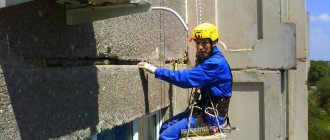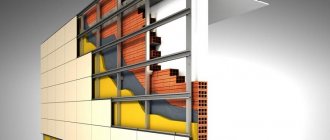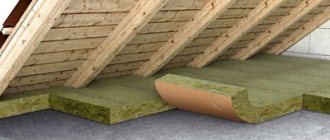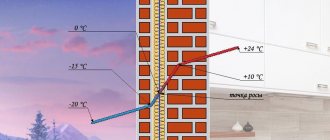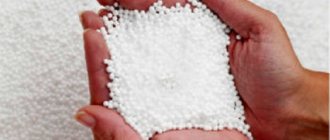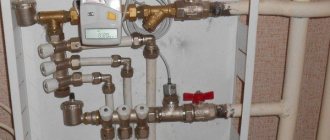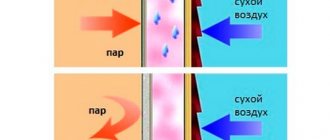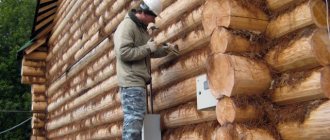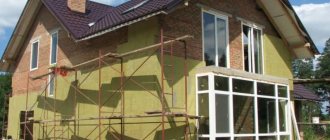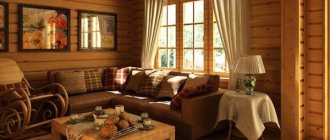Home / Articles / How to properly insulate interpanel seams in a panel house / Repair of interpanel seams and the technology for their insulation / How to determine the series of a house and calculate the volume / How to seal interpanel seams in an apartment / Sealing seams - determining the price / Who should repair interpanel seams in a house / How force the management company to seal the interpanel seams? / Reasons for the appearance of mold on the walls of an apartment / The walls in a panel house freeze, what should I do? / Typical mistakes in sealing joints between panels / How is the technical condition of interpanel joints, roofs and balconies inspected? / Frequently asked questions about sealing seams, what should I do if the seams are leaking? / How to get rid of fungus and mold on the walls of an apartment / Album of technical solutions: insulation and repair of open and closed joints / Technical instructions for sealing joints of prefabricated buildings with polymers
Primary sealing
It is carried out during the construction of a building and includes the following stages:
The seam between the panels is filled with foam; it provides not only insulation, but also additional waterproofing;
Vilatherm is placed in the seam. This is insulation with a high elasticity index, made from foamed polyethylene. The material may be cylindrical, sometimes with a hole inside. Thanks to its elasticity, the material can withstand repeated stretching and compression, which is important when a new house undergoes shrinkage. When laying the material, you need to ensure that it fits tightly to the concrete surface. If connections are made to vilates of different diameters, then the upper edge is trimmed with a wedge downwards, and the lower edge – upwards.
A sealant (mastic) is applied over the vilatherm; if all work is done correctly, the seam should be completely sealed.
Often, insulation and sealing of the seam is carried out without the use of foam; this is acceptable and does not greatly affect the final result.
Material selection criteria: what to look for
To keep the walls dry, you need to choose materials with zero vapor permeability. The following characteristics should also be assessed:
- Thermal conductivity. The lower the level, the better the insulation will be.
- Compliance with environmental standards. This parameter is especially important for residential buildings. If the insulation releases toxic substances during operation, it cannot be used to insulate seams.
- Fire safety. The minimum flammability class of the insulation must comply with the G1 standard.
- Life time. The performance properties of the material must remain identical at different stages of use.
Additional selection criteria include ease of installation and minimal volumes of construction waste after installation.
Professional polyurethane foam
Sealing joints with polyurethane foam without the use of harnesses or sealing tapes is suitable for partial or economical repairs without opening the joints.
This building material allows you to fill all the cracks and holes, and its hardening period lasts from 12 to 24 hours. The remaining parts of the foam can be cut off with any suitable device.
Sealing joints with polyurethane foam is suitable for economical repairs.
Experts do not recommend using insulation without carefully sealing moving seams. During thermal deformations, cracks may appear that allow cold and moisture to pass through.
The advantages of this option include:
- Quick and convenient placement with a nozzle gun.
- Good adhesive properties.
- Uniform distribution at the joint.
- Thermal resistance from -50 to +90 °C.
However, construction foam also has its downsides. Foaming is carried out at a temperature not lower than -10 °C, and the sealing process is accompanied by high costs associated with the cost of a foam cylinder.
Gernite cords
Elastic insulation is made on the basis of foam rubber. Due to its special structure, it is characterized by maximum water and air tightness, allowing you to simultaneously solve the problems of waterproofing and insulation. In addition, the material is characterized by durability and low cost.
Gernite cords are elastic insulation.
One of the disadvantages is the heavy weight - a linear meter of gernite cord with a cross-section of 50 mm weighs 1.5 kg. If the surface layer is damaged, the thermal insulation properties of the material will be greatly reduced.
Polyethylene foam harnesses
Cords based on foamed polyethylene are actively used for heat and waterproofing work when processing seams between the slabs of a panel house.
This elastic insulation is not subject to deformation during compression and retains its shape well throughout the entire period of operation. The list of negative aspects is limited only by the high cost of the harnesses.
Mineral wool
Mineral wool refers to an insulating material that contains extruded stone chips. The internal cavities of the slab consist of 90% air, which has a minimum thermal conductivity coefficient.
Mineral wool contains stone chips.
There are 3 types of mineral wool on sale:
- Basalt. It is in greatest demand due to ease of installation, accessibility and effective thermal insulation. But the material is not used to process the façade of the house.
- Glass wool. It was widely used in the 20th century, but due to the likelihood of crumbling and rapid damage, it lost popularity. When laying glass wool slabs, it is important to use high-quality personal safety equipment.
- Cellulose mineral wool. Complies with environmental standards, but is highly flammable.
Sandwich panels
The material is in demand due to its ease of installation. It is made in the form of a 2-layer plate based on the following components:
- Foamed polyurethane. It is distinguished by high quality in thermal insulation of seams.
- Mineral wool. When combined with a sandwich panel, mineral wool is not subject to the destructive effects of moisture.
- Foam plastic. Cheap insulation is lightweight and affordable.
Styrofoam
The most common insulation on the domestic market, which is not afraid of precipitation or ultraviolet radiation.
The service life is 30-50 years. The foam boards are fixed with dowels or using special glue. The negative point is the release of toxic substances when ignited.
Polystyrene foam is the most common insulation material.
Sealant
Using sealants, you can seal hard-to-reach seams and cracks in building structures. When filling the voids with this material, a dense elastic layer is formed.
Now let's look at what mistakes are most often made when sealing interpanel joints?
For insulation, only polyurethane foam is used. Some companies consider this a simplified option, but our specialists do not use this technology, as it has disadvantages. Over time, the house will settle, causing the slabs to move. Polyurethane foam is not elastic, therefore, as a result of the movement of the slabs, the integrity of the foam will be compromised, which means water and cold will freely penetrate into the seams.
Use of low-quality Vilaterm. The use of high-quality insulating material is a very important fact, so we check the quality of vilatherm every time we purchase it. In our practice, there have been cases when, with vilatherms, such material does not provide a tight fit to the panels, that is, the material simply falls out of the seam.
Using vilatherm of the wrong diameter. When laying, it is important that it fits tightly to the walls of the seam and is in a compressed state.
Incorrect connection of insulation. One of the common mistakes that leads to the destruction of the sealing material and the opening of the seam.
Why do the seams fail?
The difference between these houses is how strongly the plates move between each other in spring and autumn. Houses built in the Soviet Union were built of better quality using the same construction technology, and the low number of storeys of the same “Khrushchev” buildings makes them even more stable. The most susceptible to deformation are the expansion joints between the segments of the building, which precisely serve for the free movement of parts of the building in the off-season, so they are covered with specially bent galvanized sheets, or sealed with polyurethane sealant. A list of regulatory documents according to which interpanel seams were sealed can be found at the end of the article.
Secondary sealing
Repeated work on sealing the joints between the slabs can be carried out using two technologies:
Without opening the seam. New sealant is applied to the old sealant (mastic joint repair) or over the concrete joint. In this case, it is very important that the seam is cleared of foreign debris and elements that are weak to adhere to. A carpet brush is used to clean the joint, after which the seam is treated with a solvent.
The second option involves opening the seam and completely cleaning it, removing the old sealing material. For cleaning, a hammer drill and a chisel and hammer are used to remove old material. After which the seam is degreased and goes through the stages of primary sealing.
Often, when carrying out this procedure, companies with unqualified employees make a mistake - poor-quality cleaning of the seam from old material.
Preparatory activities
At the preparation stage, you should purchase the optimal amount of building materials. It is calculated based on the area of the walls without taking into account windows. The result obtained should be increased by 20%.
In addition to the insulating material, you need to buy a sealant for sealing the seams, as well as a number of consumable components. Among them are dowels, reinforcing mesh, plaster, and glue. For laying mineral wool, iron slats and screws are used.
A drill is included in the required tool kit.
If work will be carried out at height, it is necessary to prepare scaffolding. The tool kit also includes a safety net, a drill and a set of spatulas.
When preparing the walls, you need to get rid of the old coating by removing plaster and cracked paint from the surface. At this stage, it is important to coat the joints with putty and seal with plaster. The insulation is installed only on a flat and clean wall. If it is skewed, it will need to be leveled.
A little about the technology of sealing interpanel joints
The simplest and cheapest sealing option is to coat the joints, but unfortunately, this method does not bring the expected results, moisture penetrates the seams and enters the home, drafts continue to flow along the walls and bring cold into the home.
The fact is that during rain, a large amount of water collects on the roof of the bay window and it flows along the seams, constantly leaking into the apartments, especially in areas where a vertical seam intersects with a horizontal one. The surface sealing method is often used by home management companies, where the main thing is to make the work look like it is done, and not to do the job properly.
Sealing the seam between the panels and filling it with foam is a good option, although not strong enough. This technology involves drilling the seam to create holes through which the void between the panels will be filled with polyurethane foam. This method is usually used when the distance between the slabs is minimal or the interpanel seams are firmly closed with cement-concrete mortar.
At the same time, there is emptiness in such seams and dampness and cold pass through them into the room. In addition, when a building settles, the slabs always shift and cavities form, which can expand over time, especially in the seams, since this is the weakest point.
It is impossible to lay vilatherm from the outside, so the voids are filled with foam, and the seam from the outside is covered with mastic. With a competent approach and compliance with all technologies, this is a fairly reliable method, especially if the foam is not affected by climatic influences.
Warm seam
This is one of the most effective and common methods. To implement it, the joint cavity is foamed and vilaterm is placed in it, after which a layer of sealant is applied to the surface of the seam. At first glance, the “warm seam” technology is impeccable, but as practice shows, it also has disadvantages, or rather difficulties in operation. Panel slabs are produced with a thickness of 20 cm, while vilatherm is 3-4 cm, with another 16 cm remaining, but there are slabs with a greater thickness and this space will remain empty. The seam will be protected for several years, but then the vilatherm will turn into dust, begin to crumble, and the problem with the seams will again become acute for the owners. If the joint is heavily foamed, the foam will push both the vilatherm and the sealant out, which is, of course, unacceptable. Therefore, when using the “warm seam” technology, the joints must be foamed very carefully. It is described in more detail and in detail with examples on the page about sealing interpanel seams
Sealing seams in panel houses
In this case, it is assumed that the joint between the panels is completely filled, where the final stage is the application of a sealing layer of mastic. When the material is completely foamed, it comes out, so it doesn’t make any sense to lay Vilatherm and mastic right away. You need to wait a few hours, or better yet a day, until the foam gets stronger, then you need to remove its excess, lay the vilatherm and apply mastic. If the joints are filled through holes that are pre-drilled, then the technology is the same. Foam is injected into the holes, which are then tightly closed. The foam, not finding a way out, is forced to fill all the voids inside.
Is it necessary to open the seam?
There are a number of factors under which the seam must be opened, namely:
- The material from the seam disintegrates when struck with the sharp edge of a climbing hammer;
- The seam is surface plastered and a light layer of sealant is applied to it;
- The wall is very old and the material falls off even with a light touch.
Such seams must be opened, filled and sealed. If the seam is securely concreted or the slabs fit tightly enough to one another, then tearing down the walls is not recommended. It is more advisable to drill neat holes and foam the voids. Some people believe that in order to ensure thermal insulation of the seam, it is necessary to lay vilatherm. This is not so, the fact is that vilatherm itself does not provide heat, it only protects the seam from the penetration of cold by “sealing” the joint. If the seam is foamed correctly and reliably, then heat leakage will not occur.
Features of sealing interpanel seams
Today, before starting renovations on apartments in a new building, owners have to wait several years for the house to settle. As a result of settlement of the house, voids and cracks form between the slabs, which must be repaired. Houses that were built during the cold period have a number of disadvantages. The panels often did not always have time to dry thoroughly and reached their condition already during the construction process. As a result, due to temperature changes and high humidity inside the slab, its integrity was compromised, since in cold weather the water inside the concrete froze and destroyed the slab.
Sealing of joints between panels should be carried out during the construction stage. The work should be carried out from an elastic material that has good resistance to the negative influences of the environment, because practice has already proven that the structure of solid materials is quickly destroyed due to the constant (even microscopic) movement of panel slabs.
Rococo embroidery master class for beginners
Among the huge number of different embroidery techniques, it is difficult for a novice master to choose the right one. If there are no embroidery skills, then not everyone will dare to take on something that seems unusually difficult. However, there are those who are not afraid of difficulties and take on what they like best. One of these types is Rococo embroidery. For beginning craftsmen, it seems very difficult due to the ornateness and variety of ornaments and patterns. This is actually a very easy technique to learn.
Seam sealing at a professional level
To ensure thermal and waterproofing, it is necessary that all joints and cavities between the slabs be filled and sealed. Only properly sealed seams provide comfortable and healthy living conditions. As practice has shown, the most effective method of insulation today is the “warm seam”.
In the past century, the seam was filled with tow and rubber; recently, new materials and techniques have appeared on the market, which have made it possible to significantly improve the technology of sealing seams and guarantee high results. For this purpose use:
- Swellable cords made on the basis of hydrophilic rubber;
- Cement mortar is common;
- Dowels and specialized profiles.
But such sealing methods cannot give a good result due to:
- Different thicknesses of gaps between plates;
- Chips and microcracks of slabs;
- A defect that could occur as a result of non-compliance with construction technology.
Houses made of sandwich panels once received an unfortunate practice. The first buildings built using the new method had to be strong and warm, since the structure was made of two strong slabs. But over time, it turned out that there was an empty space between the panels, although in theory it should have been filled with insulation, in practice it was not there, as a result, air accumulated in the empty space, which created drafts. Due to the large number of empty cavities, such houses did not warm up well and cooled down quickly. Condensation led to the formation and active reproduction of mold and mildew, which became faithful neighbors.
Why do you need to seal the space between the slabs?
Particularly important is the external seal, filling the voids between vertical and horizontal slabs.
Primary coating is suitable for all types of slabs that are involved in the formation of load-bearing and partition walls - monolithic, SIP, sandwich, wooden and even metal.
It will be necessary to re-coat the seam space in the following cases:
- Incorrect design of the construction project.
- Significant violations of the technology of the construction process, regulated by SNiPs and SN.
- Displacement of panels due to installation carried out with errors, resulting in incorrect shrinkage of the structural part of the wall.
- Deformation of panels due to harsh climate (temperature changes, prolonged precipitation) and destructive external mechanical factors.
- Incorrect execution of stages of the construction process.
- The use of low-quality consumables, as well as products with different elasticities that are incompatible with each other.
- Strong tension of self-adhesive sealing tapes (garnit cord, leading to destruction of the cement composition).
- Low quality of concrete from which the slabs are made.
The basic regulatory rules that are used in work when sealing panel seams are:
- SNiP 3.03.01-87.
- CH 420-71.
- TR 196-08.
- VSN 40-96.
- VSN 19-95.
The consequences of lack of sealing lead to the following factors:
- Formation of drafts.
- Freezing of walls.
- Wet corners.
- Mold formation.
- Lack of sufficient heat.
- Low sound and noise insulation.
Sealing the seams of the primary or secondary plan, after preparing, jointing and cleaning the space, is carried out using:
- polyurethane foam;
- insulation type "Vilatherm";
- mastic-sealant.
Sometimes it is allowed to fill the seams with construction adhesive, cement-sand mortar of strong brands of Portland cement (for example, M500). But in practice, sealing can be done with several substances at once. The main thing is that small voids are filled.
Identification of defects requiring insulation and sealing is carried out visually, as well as with the help of industrial devices - thermal imagers, which identify areas of the wall with heat loss.
Step-by-step sealing of interpanel seams
Sealing seams in buildings of this type is a very painstaking and time-consuming job that requires experience and specific knowledge. Our company’s employees, thanks to many years of experience, have been able to master the technology of closing seams for such houses.
To reliably fill the seams, our employees use special foam, which, when expanded, penetrates even small cracks and reliably fills all voids. Vilater blocks the foam from escaping to the outside, as a result, the entire flow goes inside, and the sealant reliably protects the seams from moisture penetration.
Protection of the upper floors should begin with sealing the seams
The reputation of panel houses suffers greatly due to poor waterproofing, especially on the top floors. In most cases, the space between the slabs in such buildings is not filled with anything, and this is a fact proven by practice and experience. In addition, the roofing material of balconies and loggias does not meet the waterproofing requirements.
The technical floor becomes a place where rainwater steadily accumulates after every rain, which penetrates into the apartments through drainage channels and empty seams, and the upper floors are the first to suffer.
To free your apartment from the constant penetration of dampness, drafts and cold from the roof, it is enough to properly insulate the joints and repair the roof on the loggia. To do this, craftsmen remove the old material and lay in a new one that has good strength and elasticity. Additionally, the work uses a burner and special modern waterproofing materials. Next, waterproofing of vertical joints in the area of the customer’s apartment is carried out on all floors. Afterwards, the joints between the panels are cleaned, where vilatherm and polyurethane foam are laid. Afterwards, the seam must be thoroughly coated with waterproofing material – mastic. Only compliance with this technology can guarantee a high result of waterproofing work and provide dry and warm walls in the premises.
The edge of a concrete wall with joints is often jagged and uneven, so if the joints are not sealed carefully, they begin to leak. The problem is that the seams on the inside of the slab are inaccessible for work, so the only solution is to carefully waterproof the joints on the outside.
Thermal insulation of corner vertical joints in external wall panels
Particular attention should be paid to thermal insulation of corner vertical joints
of external walls
, where
heat loss is maximum
. For this purpose, the following measures are applied:
- install insulating liners
(Fig. 4, item 2), - perform an internal bevel of the corner
, - install external insulating pilasters
, - They supply additional heat
at the junction between the panels from a monolithic or freely installed
additional heating riser
.
In buildings with transverse load-bearing walls, insulation of external corners
thickened end external walls,
characteristic of such buildings , or
the installation of an additional internal panel
(Fig. 4).
The implementation of insulation and insulation
of corner joints
in
external wall panels
is shown in Fig. 4
10 mm
and of the same depth
is removed along the edges of the joints In addition, it is RECOMMENDED to arrange a smooth frame
at least
10 mm
.
Sealing seams in different types of houses
Sealing technology is selected for each home and case individually, since there are many factors that must first be calculated and taken into account. At the same time, craftsmen also consider the economic feasibility of using one or another sealing method.
Our company uses the “warm seam” technology for its work; today this is perhaps the only reliable, proven method that gives high results. The secret of our company is that we use our own, improved and time-tested technology for waterproofing seams. We use Vilaterm as a sealant, a material characterized by high wear resistance, Macroflex sealant and Oxyplast mastic.
Previously, houses of the KOPE type were built from sandwich panels that were empty inside. The tightness of the adhesion of such panels was simply terrible; as a result, the houses were not distinguished by good thermal insulation and airtightness.
Let us say right away that sealing seams using foam does not bring the desired result due to the specifics of the material; the foam did not linger in the seams after filling, but spread throughout the interpanel space. To achieve good tightness, a vilatherm seal is used. This material has already proven its effectiveness in ensuring tight sealing of seams and sealing.
In houses of the p.44 and p.44t series, problems periodically arise associated with chips on the slabs or with the formation of large seams between the panels, through which heat leaves the house, a draft penetrates from the street and condensation forms. In winter, such walls are not protected from the cold, as a result, fungus and mold become permanent residents in such apartments, and drafts also add to the dampness.
In such cases, interpanel joints are sealed using the “warm seam” technology. If the width of the joint does not allow the use of Vilaterm insulation, the seam is reliably foamed and covered with sealant on top. Construction foam has good resistance to environmental influences and can perform its functions for a long time.
To be fair, it should be noted that blown seams are not only a drawback of panel houses. Monolithic brick buildings also face this problem; poor sealing is especially often observed at the junction between the brickwork and the concrete monolithic floor. Similar problems also often arise at the junction of brickwork and windows. From personal experience, we can say that such seams must be sealed very carefully, using not only foam, but also sealed plaster.
Sealing joints that were previously plastered
Often, instead of sealing, utility workers simply plaster the walls and seams, but these actions do not solve the problem, the void between the seams remains, water and cold air constantly penetrate into apartments, as a result, the home is cold and uncomfortable, fungus and mold develop, which not only allows you to create comfortable living conditions, but also negatively affects the health of residents. Over time, dampness destroys the plaster layer and cracks open.
Of course, it is not always necessary to open the seam completely. Such measures are taken if the joint between the panels is narrow or the plaster is held tightly, then construction foam is used. Holes are made in the plastered seam, every 20-30 cm, foam is released through them, which penetrates into all the cracks and fills the entire space. Afterwards, a layer of sealant – mastic – is applied to the plaster; this coating will provide additional protection against moisture penetration.
Execution steps
Regardless of the technology used and the type of insulation, work begins only after preparatory measures have been carried out. All materials are purchased in advance, and subsequent actions are carried out strictly according to the instructions.
Installation of insulation
The glue is spread over the cleaned surface in several layers. If the wall is curved, it can be leveled with an adhesive mixture, but not more than 2 cm.
Then, in the direction from bottom to top, you need to fix the foam plates. After fixing the material, strengthen the fastening with dowels. To do this, holes are made in the slab, an expansion hood is installed and the fasteners are hammered in.
Glue and insulation are distributed over the surface.
Reinforcement
Unlike mineral wool, foam plastic does not require the use of panel materials. However, since it is quite fragile, it needs to be additionally reinforced using iron mesh.
In multi-storey buildings this is done end-to-end. If you overlap the reinforcement, the plaster layer will begin to delaminate.
Padding
The primer composition is distributed before puttingtying the reinforced coating. It is better to apply it in 3 layers, and plastering only after drying.
Plaster
Finishing with a plaster base and painting allows you to disguise the foam under the facade. In this case, people will not be able to notice the joints between panels or insulating sheets, and the appearance of the room will be refreshed.
Plaster allows you to disguise the insulation.
Painting
Waterproof compounds are used to paint plastered surfaces. If there are no financial restrictions, it is better to purchase insulating paint to consolidate the results.
Sealing seams at the joints of loggias and windows
The design of loggias and balconies implies the presence of joints between the slabs and walls, through which water can penetrate during rain. Constant dampness negatively affects materials, destroys them, develops fungus in them, and mold appears on the walls and ceiling. If the loggia is also blown out, then the furniture and materials on them begin to deteriorate, and there is nothing to say about comfort.
To eliminate drafts and moisture penetration inside, you need to provide sealing. Before starting work, the loggia must be carefully examined by employees of the sealing company, which will allow you to first draw up a competent work plan and select the necessary materials.
Step-by-step pattern for embroidering a rose
Starting is always difficult. However, it is not for nothing that they say: “If you are afraid of wolves, do not go into the forest.” If a student does not practice mastering the acquired knowledge, then he will never become a real master. Therefore, learning to embroider in the Rococo style and master class on embroidering a rose is one of the most important steps in mastering this craft.
Having prepared everything necessary, novice craftsmen can begin to implement a simple embroidery pattern for their first flower:
- Choose the color of the future rose and thread the needle, tying a knot at the end.
- Thread the needle from the inside out at the place of the first stitch.
- Make a stitch of 5-6 turns.
- Then the remaining stitches are made, forming the petals of the future flower. Formation principle: from the center, each new petal is slightly longer.
- Make the final stitches of the flower for 15-18 turns.
- Thread the needle with a thread of the color of the stem and leaves.
- Thread from the inside out at the location of the leaves or stem. Preliminarily outline the location of the elements with a pencil.
- Make the corresponding stitches according to the drawing.
By following simple instructions, future craftsmen will be able to master all the secrets of craftsmanship and in the future embroider the most incredible compositions and ornaments.
Today this type of decorative and applied art is very popular. Many fashion designers use embroidered elements in their collections. Rococo embroidery on knitted items and items is especially in demand among modern fashionistas. Having learned the basics of embroidery, many decorate their personal wardrobe with patterns in the Rococo style.
Popular posts
- Chair for dressing table Chairs for dressing tables in Moscow - 189 Products Company from Moscow, delivery 29643 a In…
- Silicone sanitary sealant Silicone sanitary sealant white in Moscow - 1491 products Company from Moscow, delivery (tomorrow) 140...
- Shelf in the hallway Currently, there are a huge number of different options for shelves in the hallway, and this is directly ...
- TechnoNIKOL insulation characteristics TechnoNIKOL - technical characteristics of the material and its wise choice In the cold season, you want…
What advantage does sealant have over other building materials?
According to its technical characteristics, the sealant has good elasticity, which allows the material to adapt to external changes, slab shifts and other deformations that may occur as a result of the operation of the building. A high-quality sealant withstands exposure to sunlight well and is a reliable protection for foam, which can collapse under the influence of UV rays. At the same time, the sealant protects the foam not only from sunlight, but also from moisture, and prevents the formation of flax, mold, and fungus inside the seam.
Our specialists use only materials proven by experience and time, which provide long-term safety for the seam and the apartment (house) from moisture.
A question or request for work using the warm seam technology method for a panel building can be submitted to the contact phone +7 (495) 585-79-00 or sent right now: Order
Frequently asked questions about sealing seams: / How to properly seal internal seams between slabs / Who should I repair the interpanel seams in my house? / Sample application to the Management Company for the repair of interpanel seams / Secrets of correctly writing an application for interpanel seams in the management company / Reasons for the appearance of mold on the walls of an apartment / Walls freeze in a panel house, what should I do? / Typical mistakes in sealing seams between panels
Our prices
Prices are real and valid for September 2022.
All prices include labor, delivery, etc. (except where indicated for legal entities). This is the final price.
Price for private orders
Phone number for private orders - +7 (910) 464-47-42
| Name of works | Change | Price |
| Sealing of seams using the “Warm seam plus” technology | rub / linear m | 600 |
| Sealing of seams using the “Warm seam plus” technology with gating | rub / linear m | 800 |
| Secondary sealing without opening | rub / linear m | 300 |
| Treatment of interpanel seams with an antifungal agent | rub / linear m | 100 |
Price for legal entities
| Name of works | Change | Price |
| Primary sealing (no material, only work) | rub / linear m | 130* |
| Complete turnkey sealing. 3 year warranty. | rub / linear m | 260* |
| "Warm seam plus." 5 year warranty. | rub / linear m | 384* |
| Grooving plastered or concrete joints. | rub / linear m | +110* |
*Price may vary depending on the complexity of the work. The final cost is determined after an inspection by a technologist.
We prepare KS-2 and KS-3 reports.
